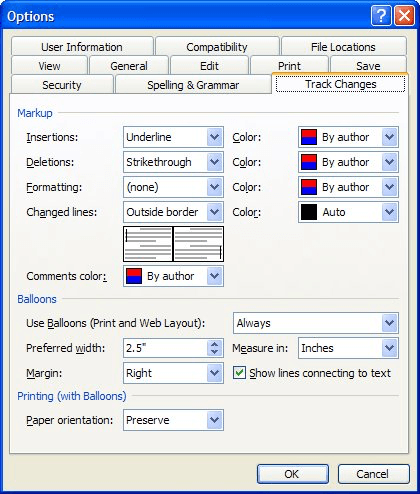Please Note: This article is written for users of the following Microsoft Word versions: 97, 2000, 2002, and 2003. If you are using a later version (Word 2007 or later), this tip may not work for you. For a version of this tip written specifically for later versions of Word, click here: Changing How Changes are Noted in Word.
Written by Allen Wyatt (last updated August 19, 2023)
This tip applies to Word 97, 2000, 2002, and 2003
If you use the Track Changes feature of Word, you know how your document looks as you make changes. Added text is shown in some different color, and deleted text is shown with a strikethrough or in balloons to the side of your text. You may want to change how Word shows your changed text. Fortunately, Word allows you great flexibility in this area. To make your configuration changes, follow these steps:

Figure 1. The Track Changes tab of the Options dialog box.
In Word 97 and Word 2000, the Track Changes tab allows you to specify four different ways in which changes can be tracked:
In Word 2002 and Word 2003 the options available on the Track Changes tab are a bit different:
WordTips is your source for cost-effective Microsoft Word training. (Microsoft Word is the most popular word processing software in the world.) This tip (40) applies to Microsoft Word 97, 2000, 2002, and 2003. You can find a version of this tip for the ribbon interface of Word (Word 2007 and later) here: Changing How Changes are Noted in Word.

Do More in Less Time! An easy-to-understand guide to the more advanced features available in the Microsoft 365 version of Word. Enhance the quality of your documents and boost productivity in any field with this in-depth resource. Complete your Word-related tasks more efficiently as you unlock lesser-known tools and learn to quickly access the features you need. Check out Microsoft 365 Word For Professionals For Dummies today!
If you have a group of people working on a single document, you may wonder what tools are available in Word to facilitate ...
Discover MoreTrack Changes is a great tool for editors and collaborators to use when creating documents. An author, seeking changes ...
Discover MoreIf you are editing a document with Track Changes turned on, Word won't let you delete a column in a table and have it ...
Discover MoreFREE SERVICE: Get tips like this every week in WordTips, a free productivity newsletter. Enter your address and click "Subscribe."
There are currently no comments for this tip. (Be the first to leave your comment—just use the simple form above!)
Got a version of Word that uses the menu interface (Word 97, Word 2000, Word 2002, or Word 2003)? This site is for you! If you use a later version of Word, visit our WordTips site focusing on the ribbon interface.
Visit the WordTips channel on YouTube
FREE SERVICE: Get tips like this every week in WordTips, a free productivity newsletter. Enter your address and click "Subscribe."
Copyright © 2025 Sharon Parq Associates, Inc.
Comments